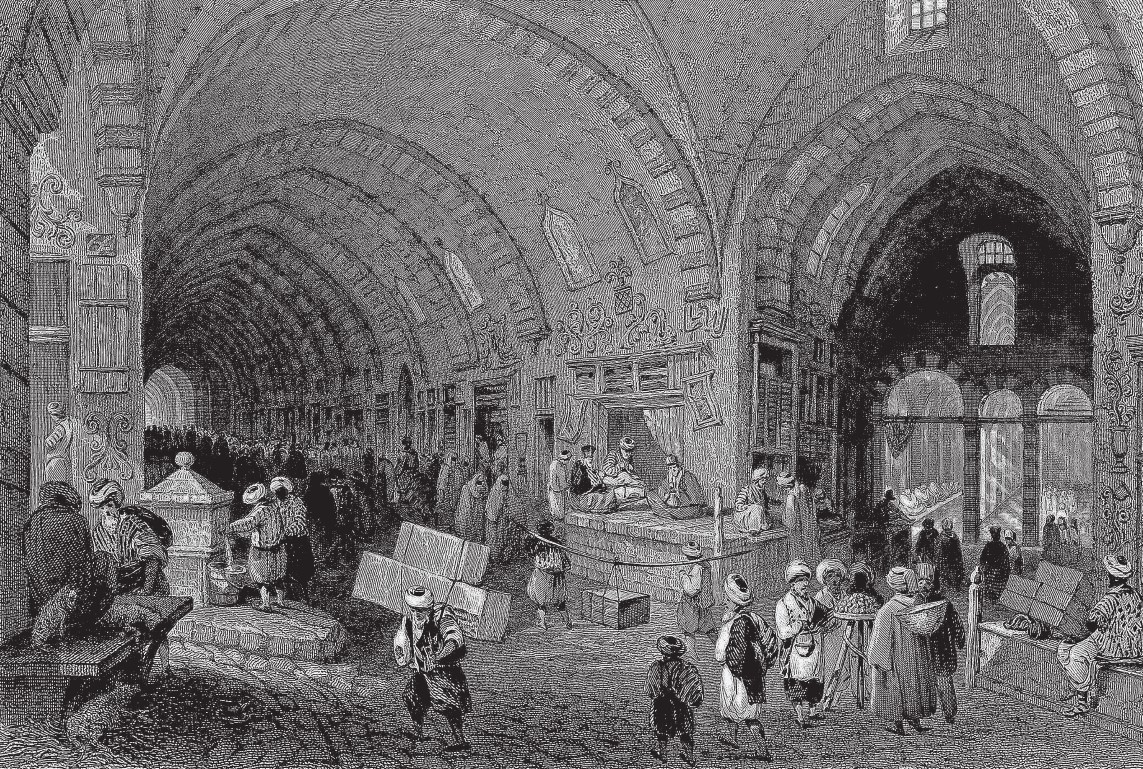Ottoman Bazaars in Anatolia and the Balkans
An Overview of Influences in Defining Spatial and Architectural Qualities
DOI:
https://doi.org/10.31522/p.32.1(67).12Keywords:
Anatolia, Balkans, bazaar, historic commercial space, Ottoman city bazaarsAbstract
Bazaars were spaces that formed the center of the cities during the Ottoman period, had a certain order, and were shaped spatially and architecturally depending on the geographical-topographical characteristics and commercial potential of each city. Proximity to the citadels, connection with city gates and main roads, relations with Friday mosque and other public buildings in the city were the main factors shaping the bazaar spatially. In bazaars, where bedesten and khans, and in some cases covered bazaar-arastas, appeared on a building scale, shops that lined on open or covered streets formed the architecture of the bazaar. In addition to these, the sovereignty and order established by the state over trade during the Ottoman period, the institution of waqf, and the guilds of tradesmen also played a decisive role in the bazaar. With the bazaars examined, it is concluded that while administrative and commercial influences in the shaping of bazaars in Anatolian and Balkan cities during the Ottoman period created bazaar spaces with similar qualities, urban inputs led to the differentiation of bazaars in terms of scale, spatial and architectural qualities.
References
Akar, T. (2009a) ‘Osmanlı Kentinde Ticari Mekânlar: Bedesten-Han-Arasta-Çarşı Mekânları Literatür Değerlendirmesi’, Türkiye Araştırmaları Literatür Dergisi, 7(13), pp. 267-292.
Akar, T. (2009b) The Role of Vakıf Institution in the Conservation of Vakıf Based Cultural Heritage. Ph.D. Middle Esat Technical University.
Ayverdi, E.H. (2000) Avrupa’da Osmanlı Mimari Eserleri. I, III, IV. 2nd ed. İstanbul: Fetih Cemiyeti Publications.
Barkan, Ö.L. (1942) ‘XV. Asrın Sonunda Bazı Büyük Şehirlerde Eşya ve Yiyecek Fiyatlarının Tesbit ve Teftişi Hususlarını Tanzim Eden Kanunlar III’, Tarih Vesikaları, 9(II), pp. 168-177.
Boykov, G. (2011) ‘Reshaping Urban Space in the Ottoman Balkans: a Study on the Architectural Development of Edirne, Plovdiv, and Skopje (14th-15th centuries)’. In: Hartmuth, M. (ed.) Centres and Peripheries in Ottoman Architecture: Rediscovering a Balkan Heritage. Sarajevo: Cultural Heritage Without Borders, pp: 32-45.
Boykov, G. (2015) ‘The Borders of the Cities: Revisiting Early Ottoman Urban Morphology in Southeastern Europe’. In: Baramova, M.; Boykov, G., and Parvev, I. (eds.) Bordering Early Modern Europe. Wiesbaden: Harrassowitz Verlag, pp. 243-256. https://doi.org/10.2307/j.ctvc2rkd9.21
Caner Yüksel, Ç. (2015) ‘The Making of the Commercial Center in Tire (14th-16th Centuries), Middle East Technical University Journal of Faculty of Architecture (METU JFA), 32(1), pp. 147-164. https://doi.org/10.4305/METU.JFA.2015.1.8
Cezar, M. (1983) Typical Commercial Buildings of the Ottoman Classical Period and the Ottoman Construction System. İstanbul: İş Bankası Publications.
Cerasi, M. (1998) ‘The Formation of Ottoman House Types: A Comparative Study in Interraction with Neighboring Cultures’, Muqarnas, 15, pp. 116-156. https://doi.org/10.2307/1523280
Cerasi, M. (2001) Osmanlı Kenti. 2nd ed. İstanbul: Yapı Kredi Publications.
De Amicis, E. (1878) Constantinople (C. Tilton, trans.). 4th ed. New York: G.P. Putnam’s Sons.
Ergenç, Ö. (1980) Osmanlı Şehrinde Esnaf Örgütlerinin Fizik Yapıya Etkileri. In: I. Uluslararası Türkiye’nin Sosyal ve Ekonomik Tarihi Kongresi. Ankara: Meteksan, pp. 103-109.
Ergenç, Ö. (2013) Osmanlı Tarihi Yazıları: Şehir Toplum Devlet. İstanbul: Tarih Vakfı Yurt Publications.
Ergin, O. (1945) Çarşı. In: İslam Ansiklopedisi, III, İstanbul: Milli Eğitim Bakanlığı Publications, pp. 360-362.
Eyice, S. (1992a) Bedesten. In: Türkiye Diyanet Vakfı İslam Ansiklopedisi, V, İstanbul: Diyanet İşleri Başkanlığı Publications, pp. 509-513.
Eyice, S. (1992b) ‘Büyük Çarşı’, In: Türkiye Diyanet Vakfı İslam Ansiklopedisi, VI, İstanbul: Diyanet İşleri Başkanlığı Publications, pp. 302-311.
Faroqhi, S. (1978) ‘The Early History of the Balkan Fairs’, Südost Forschungen, XXXVII, pp. 50-68.
Faroqhi, S. (2000) Osmanlı’da Kentler ve Kentliler. İstanbul: Tarih Vakfı Yurt Publications.
Gha ripour, M. (2012) The Bazaar in the Islamic City Design, Culture, and History. Cairo: The American University in Cairo Press. https://doi.org/10.5743/cairo/9789774165290.001.0001
Goodwin, G. (2003) A History of Ottoman Architecture. London: Thames & Hudson.
Gülersoy, Ç. (1979) Kapalı Çarşının Romanı. İstanbul: İstanbul Kitaplığı Publications.
Halaçoğlu, Y. (2002) Osmanlılarda Ulaşım ve Haberleşme. Ankara: PTT Genel Müdürlüğü.
Hartmuth, M. (2011) ‘The History of Centreperiphery Relations as a History of Style in Ottoman Provincial Architecture’. In: Hartmuth, M. (ed.). Centres and Peripheries in Ottoman Architecture: Rediscovering a Balkan Heritage. Sarajevo: Cultural Heritage Without Borders, pp: 18-29.
Hartmuth, M. (2016) ‘Building the Ottoman City – A Linear or Cumulative Process? Lessons from Fifteenth-Century Skopje’, Centre and Periphery? Islamic Architecture in Ottoman Macedonia, 1383-1520, working paper 3, pp: 1-16.
İbrahimgil, A. (2022) ‘Comparison of Ottoman Era Skopje Bazaar with Similar Bazaars’, Technics Technologies Education Management, 17(2), pp. 45-54.
İnalcık, H. (1980) ‘The Hub of the City: Bedestan of İstanbul’, International Journal of Turkish Studies, I, pp. 1-17.
İnalcık, H. (2005) ‘Türkler ve Balkanlar’, Bal-Tam Türklük Bilgisi, 3, pp. 20-44.
İnalcık, H. (2012) Tımar. In: Türkiye Diyanet Vakfı İslam Ansiklopedisi, 4I, İstanbul: Diyanet İşleri Başkanlığı Publications, pp. 168-173.
İslamoĞlu, A. (2017) ‘Osmanlı Devleti’nde Esnaf Loncaları’, İstanbul Üniversitesi Hukuk Fakültesi Mecmuası, LXXV, pp. 447-456.
Kal’a, A. (1994) Esnaf. In: Türkiye Diyanet Vakfı İslam Ansiklopedisi, XI, İstanbul: Diyanet İşleri Başkanlığı Publications, pp. 423-430.
Kazıcı, Z. (1988) Ahilik. In: Türkiye Diyanet Vakfı İslam Ansiklopedisi, I, İstanbul: Diyanet İşleri Başkanlığı Publications, pp. 540-542.
Kiel, M. (1990) Studies on the Ottoman Architecture of the Balkans. Hampshire: Variorum
Krstikj, A. (2013) Values of the Historic Urban Form of Skopje’s Old Bazaar Based on Analysis of the Ottoman Urban Strategy. Ph.D. Osaka University. https://doi.org/10.18910/34483
Kuba n, D. (1968) ‘Anadolu-Türk Şehri Tarihi Gelişmesi, Sosyal ve Fiziki Özellikleri Üzerinde Bazı Gelişmeler’, Vakıflar Dergisi, VII, pp. 53-73.
Kuban, D. (2007) Osmanlı Mimarisi. İstanbul: Yapı Endüstri Merkezi Publications.
Kumbaracı Bogoyeviç, L. (2008) Üsküp’te Osmanlı Mimari Eserleri. İstanbul.
ÖzdeŞ, G. (1998) Türk Çarşıları. Ankara: Tepe Publications.
Özer, M. (2016) ‘Balkanlarda Osmanlı Kenti ve Mimarlık Mirası’, Restorasyon Yıllığı, 13, pp. 123-132.
Pardoe, M. (1839) The Beauties of the Bosphorus. London: George Virtue, 26, Ivy Lane.
Pinon, P. (2008) ‘The Ottoman Cities of the Balkans’. In: Jayyusi, S.K. (ed.) The City in the Islamic World, 1, Leiden-Boston: Brill, pp. 143-158. https://doi.org/10.1163/ej.9789004162402.i-1500.41
Raymond, A. (2008a) ‘The Spatial Organization of the City’. In: Jayyusi, S.K. (ed.) The City in the Islamic World, 1, Leiden-Boston: Brill, pp. 47-70. https://doi.org/10.1163/ej.9789004162402.i-1500.15
Raymond, A. (2008b) ‘The Economy of the Traditional City’. In: Jayyusi, S.K. (ed.) The City in the Islamic World, 2, Leiden-Boston: Brill, pp. 731-752. https://doi.org/10.1163/ej.9789004162402.i-1500.202
Şahinalp, M.S. and Günal, V. (2012) ‘Osmanlı Şehircilik Kültüründe Çarşı Sisteminin Lokasyon ve Çarşı içi Kademelenme Yönünden Mekânsal Analizi’, Milli Folklor, 24(93), pp. 149-168.
Tankut, G. (1973) Osmanlı Şehrinde Ticari Fonksiyonların Mekânsal Dağılımı. In: VII. Türk Tarih Kongresi. Ankara: Türk Tarih Kurumu, pp. 773-779.
Tankut, G. (1975) The Spatial Distribution of Urban Activities in the Ottoman City. In: Structure Sociale et Development Culturel des Villes Sub-Est Europeennes et Adriatiques aux 17.-18. Siecles. Bucharest: Association Internationale d’Etudes de Sub-Est European, pp. 245-263.
Taş, H. (2010) ‘Bursa’da Yakın Mesafeli Ticaret faaliyetlerinin Mekânı Olan Çarşılar’. In: Sevim, S. (ed.) Osmanlı Coğrafyasında Çarşı Kültürüve Çarşılar. Bursa: Bursa Büyükşehir Belediyesi, pp. 11-17.
Turan, Ö. and İbrahimgil, M.Z. (2004) Balkanlardaki Türk Mimari Eserlerinden Örnekler. Ankara: TBMM Kültür, Sanat ve Yayın Kurulu Publications.
Ülgen, A.S. (1948) Edirne Rüstempaşa Kervansarayı (Hanı) kesit ve plan çizimleri. Salt Research Available at: https://archives.saltresearch.org/handle/123456789/82569 [Accessed 23 May 2023].

Downloads
Published
How to Cite
Issue
Section
License
Copyright (c) 2024 Tuba Akar

This work is licensed under a Creative Commons Attribution 4.0 International License.
Copyright (c) 2021 authors and journal.
This work is licensed under a Creative Commons Attribution 4.0 International License.
Authors who publish with this journal agree to the following terms:
In agreeing this form, you certify that:
- You read the ethical codex of the PROSTOR available at journal web.
- You submitted work is your original work, and has not previously been published and does not include any form of plagiarism.
- You own copyright in the submitted work, and are therefore permitted to assign the licence to publish to PROSTOR.
- Your submitted work contains no violation of any existing copyright or other third party right or any material of an obscene, libellous or otherwise unlawful nature.
- You have obtained permission for and acknowledged the source of any illustrations, diagrams or other material included in the work of which you are not the copyright owner.
- You have taken due care to ensure the accuracy of the work, and that, to the best of your knowledge, there are no false statements made within it.
- All co-authors of this submitted work are aware of, and in agreement with, the terms of this licence and that the submitted manuscript has been approved by these authors.






